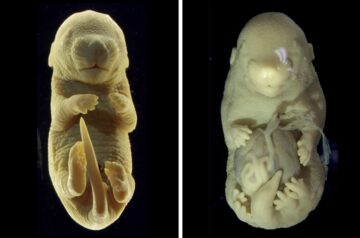Sara Reardon in Nature:
 This six-legged animal isn’t an insect: it’s a mouse with two extra limbs where its genitals should be. Research on this genetically engineered rodent, which was published on 20 March in Nature Communications1, has revealed a way in which changes in DNA’s 3D structure can affect how embryos develop. Developmental biologist Moisés Mallo, at the Gulbenkian Science Institute in Oeiras, Portugal, and his colleagues were studying one of the receptor proteins, Tgfbr1, in a signalling pathway that is involved in many aspects of embryonic development. The scientists inactivated the Tgfbr1 gene in mouse embryos about halfway through development to see how the change affected spinal-cord development. Then, Mallo’s graduate student, Anastasiia Lozovska, came to his office to tell him she’d found that one of the bioengineered embryos had genitals that looked similar to two extra hind limbs. Her finding sent the research down an unexpected path. “I didn’t choose the project, the project chose me,” Mallo says.
This six-legged animal isn’t an insect: it’s a mouse with two extra limbs where its genitals should be. Research on this genetically engineered rodent, which was published on 20 March in Nature Communications1, has revealed a way in which changes in DNA’s 3D structure can affect how embryos develop. Developmental biologist Moisés Mallo, at the Gulbenkian Science Institute in Oeiras, Portugal, and his colleagues were studying one of the receptor proteins, Tgfbr1, in a signalling pathway that is involved in many aspects of embryonic development. The scientists inactivated the Tgfbr1 gene in mouse embryos about halfway through development to see how the change affected spinal-cord development. Then, Mallo’s graduate student, Anastasiia Lozovska, came to his office to tell him she’d found that one of the bioengineered embryos had genitals that looked similar to two extra hind limbs. Her finding sent the research down an unexpected path. “I didn’t choose the project, the project chose me,” Mallo says.
Researchers have long known that, in most four-limbed animals, both the external genitalia (penis or clitoris) and hind limbs develop from the same primordial structures. When Mallo’s team looked further into the six-legged mouse phenomenon, they found that Tgfbr1 directs these structures to become either genitalia or limbs by altering the way that DNA folds in the structure’s cells. Deactivating the protein changed the activity of other genes, resulting in extra limbs and no true external genitalia.
More here.
